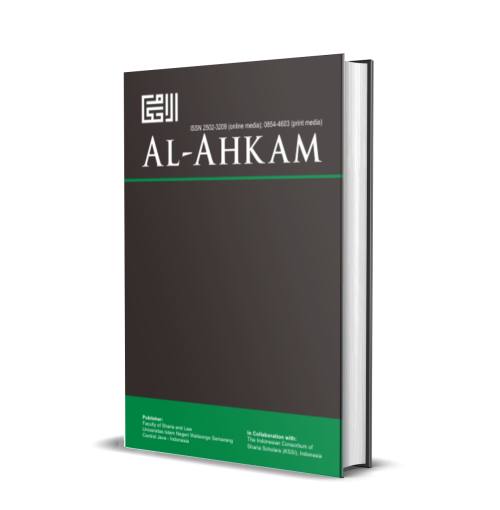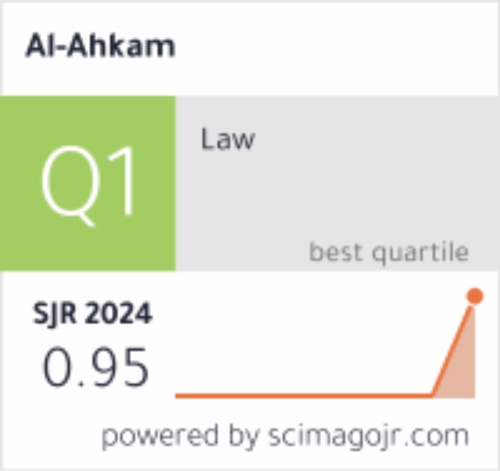PENDEKATAN EPISTEMOLOGI DAN INTERSUBJEKTIF ATAS HADIS-HADIS NIKAH MUT’AH
DOI:
https://doi.org/10.21580/ahkam.2014.24.2.147Keywords:
epistemologi, hadis nikah mut'ah, intersubjektivitas, Sunni-Syi’ahAbstract
This article offers an alternative perspective at the difference views in the Sunni and Shi’ite hadiths for Mut'ah marriage. Related to the differences both treat and apply that these hadits universally believed to be one of the fundamental sources of Islam. Eventhough, both Sunny and Shi’ite agree to put hadits as a second source of doctrine, but they often actually produce a different formulation of the law and contradictory. The difference of theological view is a fundamental problem that implies on their thought dealing with being accepted or rejected for hadits transmition of Mut’ah merriage. Intersubjectivity approach has roled to positionize these groups as an objective opinion, subjective as well. Both objectivities are located on the seriousness of their respective efforts to obtain the authenticity of the hadith, in which expectations will be both objectivity when hadith of mut’ah marriages take placed purely as historical information. In this position, the awareness together to build the Islamic civilization in the theological differences, are values that should be a priorityDownloads
References
Amin Abdullah, Islamic Studies di Perguruan Tinggi; Pendekatan Integratif-Interkonektif, Yogyakarta: Pustaka Pelajar, 2006.
al-‘Asqalānī, Ibn Ḥajar, al-. Fatḥ al-Bārī bi Sharḥ Ṣaḥīḥ al-Bukhārī taḥq. ‘Abdul Qādir Syhaibah. Madinah: Maktabah al-Mulk, 2001.
Auda, Jasser, Maqasid al-Shariah as Philosophy of Islamic Law; A System Approach. London: The International Institute of Islamic Thought, 2007.
Ḥā’irī, SyahlaShahlā, al-Mut’ah; al-Zuwāj al-Mu’aqqat ‘ind ’l-Shyī’ah Ḥālat Īrān 1978-1982, terj. Fādī ḥamūd,. Beirut: Syhirkah al-Maṭbū’āt li ’l-Tauzī’ wa ’l-Nashyr, 1996.
Haeri, Shahla, Law of Desire; Temporary Marriage in Shi’i Iran. New York: Syracuse University Press, 1989.
Hauqola, Nur Kholis, “Otentitas Sunnah dan Kedudukannya dalam Legislasi Hukum Islam” dalam Al-Ahkam; Jurnal Pemikiran Hukum Islam, Vol. 24, No. 1, 2014.
Howard, I.K.A. “al-Kutub al-Arba’ah; Empat Kitab Hadis Utama Mazhab Ahlul Bait”dalam Jurnal al-Huda, Jurnal Kajian Ilmu-ilmu Islam, Vol. II, No. 4, 2001.
‘Itr, Nūr al-Dīn. Manhaj al-Naqd fī ‘Ulūm al-Ḥadīth, Damaskus: Dār al-Fikr, 1981.
al-Khaṭīb, ‘Ajjāj al-., Uṣūl al-Ḥadīth ‘Ulūmuh wa Muṣṭalaḥuh, Beirut: Dār al-Fikr, 1989.
al-Kulainī, Abū Ja’far Muḥammad ibn Ya’qūb, al-. al-Furū’ min al-Kāfī, ditaḥqīq ‘Alī Akbar al-Ghiffārī. Iran: Mu’assasah Ans}āriyyān, 2005.
al-Musawi, Hasyim al-. Mazhab Syiah; Asal-usul dan Keyakinannya terj. Ilyas Hasan. Jakarta: Lentera, 1996.
Rahmah, Wahyuni Shifatur. “Epistemologi Hadis dalam Pandangan Sunni dan Syi’ah” dalam Jurnal Studi Ilmu-ilmu al-Qur’an & Hadis, Vol. 7, No. 2, Juli 2006.
Rasyid, Dawud, “Mawqif Ahl al-Sunnah wa ’l-Syhī’ah Naḥw al-‘Itrah al-Nabawiyyah” dalam Miqot Jurnal Ilmu-ilmu Keislaman, Vol. 37, No. 1, 2013.
al-Rāzī, Fakhr al-Dīn Muḥammad ibn ‘Umar ibn al-Ḥusain, al-Maḥs}ūl fī ‘Ilm Uṣūl al-Fiqh, taḥq. Jābir Fayyaḍal-‘Alwānī. Beirut: Mu’assasah al-Risālah, t.th.
Ṣalah, Ibn,. ‘Ulūm al-Ḥadīth, taḥq. Nūr al-Dīn ‘Itr. Beirut: Dār al-Fikr, 1986.
al-Sālūs, ‘Alī Aḥmad al-., Ma’a ‘al-Ithnā ‘Ashariyyah fī al-Uṣūl wa a‘l-Furū’. Mesir: Maktabah Dār al-Qur’ān, 2003.
Siradj, Said Agil, “The Sunni-Shi’ah Conflict and the Search for Peace in Indonesia” dalam Journal of Indonesian Islam, Vol. 7, No. 1, 2013.
al-Subḥānī, Ja’far, Uṣūl al-Ḥadīth wa Aḥkāmuhu fī ‘Ilm al-Dirāyah. Qum: Maktabah al-Tauḥīd, 1993.
Yasin, R. Cecep Lukman, “The Twelver Shi’i Understanding on the Finality of Prophethood” dalam al-Jāmi’ah, Vol. 48, No. 1, 2010.
Downloads
Published
How to Cite
Issue
Section
License
By submitting an article to the journal, the author(s) agree to transfer the published article's copyright to the journal, which will act as the publisher. This means the journal will have the right to publish the article in various forms, including reprints. The journal will maintain the publishing rights to the published articles.
In line with the license, authors and third parties (readers, researchers, and others) are allowed to share and adapt the material. In addition, the material must be given appropriate credit, provided with a link to the license, and indicated if changes were made. If authors remix, transform or build upon the material, authors must distribute their contributions under the same license as the original.




